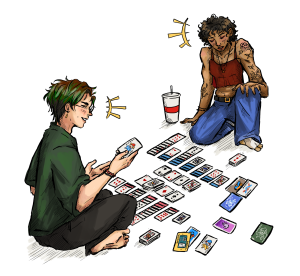Poetry Performance Techniques
May 17, 2016
Most poetry performance is a stagnant affair; the poet or poets read aloud their verses, and the audience simply listens, sometimes snapping or moaning in agreement. These three New Techniques for Poetry Performance are intended to add a physical level of audience interaction to poetry performance. There are three groups of people necessary for the performance of these techniques:
Three Groups:
The performer – The person reading the poem.
The cast – The people who are helping turn the audience into a physically interactive being. The cast should always be one quarter of the audience; the cast to audience ratio should always be 1:3.
The audience – The people attending the show.
1. The Marionette Technique: This technique is best suited to a physically capable audience; it should be used in spaces with well defined, committed audiences. The performer sits on a stool in the center of the performance area. The audience stands in three concentric circles around the performer, with no more than 6 inches between people within their circle; the distance between circles should be no more than 8 inches; the circle closest to the performer should be 12 inches from the performer. The cast makes up the outermost circle. The cast has cues to move forward and backward and physically manipulate the audience’s movements. There can be moments of stillness.
2. The Gesture Technique: This technique is also best suited to a physically capable audience; it can be used with an audience that may grow or shrink in size throughout the performance. The performer sits on a stool in the center of the performance area. The audience stands in three concentric circles around the performer; the place each person stands should be demarcated with tape. The rules of The Marionette Technique with regards to distance between audience members should be applied in placing the tape. The audience should be instructed to try to stay on their spot at all times, and if they are knocked off it for any reason, to get back on it. The performer makes large gestures throughout the performance and the audience reacts by drawing back and forth together.
3. The Storytime Technique: This technique is best suited to a younger audience, an inebriated audience, a playful audience or an audience which includes people with physical disabilities. The performer sits on the floor in the center of the performance area. The audience sits on the floor without any form of support, e.g., yoga blocks, crazy creek chairs. They sit as close to one another as possible; each person should be in physical contact with at least two other people. The cast sits among the audience, and each cast member crawls slowly on hands and knees through the audience, avoiding other cast members.





